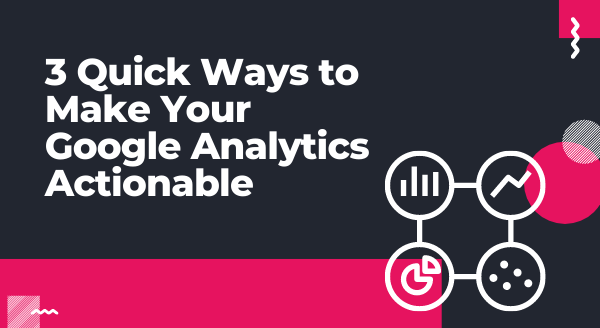
As Higher Ed websites continue to serve as a resource hub for many different audiences, it is important to utilize tracking metrics to serve as a driving force behind evolving your web strategy. Google Analytics (GA) is a free tool that tracks and analyzes your website traffic to help you develop a deeper understanding of visitors and provide actionable insights.
With or without a developer, there are many features within GA that are easy to implement and provide insights right away, but many marketers aren’t utilizing them. Here are a few of our must haves as it relates to analyzing higher ed websites.
With the amount of varying audience groups visiting your higher ed website every day, it’s important that the site is configured to identify who the visitors are and which group they belong to. Not only can this help you build a deeper understanding of your visitors, but it can also support providing each an experience that is valuable to their interest and needs.
Setting up custom audiences in GA is relatively painless if you have an idea of what you’re ultimately trying to accomplish. One way to identify a visitor beyond basic demographics is to create rules based on website behavior (i.e., anyone who requested information will be classified as a prospect). Through these audience groups, you can begin to see segmented behavioral patterns and interaction insights that support those end goals.
A great way to track how you define success is through customized goals. These goals should reflect actions or conversions that matter most and are key to understanding marketing performance. Specific to higher education websites, there are two types of goals that we think every university or college should utilize.
Request for Information - As a great first step in the application process, you want to collect information on prospective students as they flow through stages of the journey. Creating a destination goal through the final landing page URL will give insight into behaviors leading up to that final URL destination.
Event Sign Ups - Whether on-campus or virtual, creating an event goal to track signup conversions is a great way to pulse check promotion efforts. Event goals include insight into what steps visitors took or abandoned in route to the final conversion.
So you’ve got all these metrics at your fingertips, what are you doing with that information? It’s smart to set up both monthly and quarterly reviews of your key performance indicators (KPIs) to ensure that you’re making informed decisions as you update and improve key areas of your site. With a month-to-month view, you’ll be able to keep track of audience trends and make quick tweaks, while quarterly reports should be more actionable in long-term decisions.
A quick and easy way to check on an audience at any given point is through the Audience Report. Located within the audience dashboard, this report offers a full picture including demographics, location, acquisition, interests, behaviors and more.
The Behavior Flow visualizer shows the path that users take from one page to the next. Is there a path you want users to follow ultimately ending in a conversion? Is there one page that encourages continued steps over another? This can be a key indicator of on-page content performance.
Of course, there is always the option to create custom reports highlighting only the KPIs you are interested in. You choose the dimensions and metrics as well as the output of information. While it takes a little more effort to create, you can easily replicate month after month.
While GA has many different features, there are lots of opportunities for quick wins to begin seeing actionable insights immediately. With easy installation into most content management systems, including Cascade CMS, there’s no better way to maintain a real understanding of your website.
Last Updated: Mar 3, 2021 11:00 AM